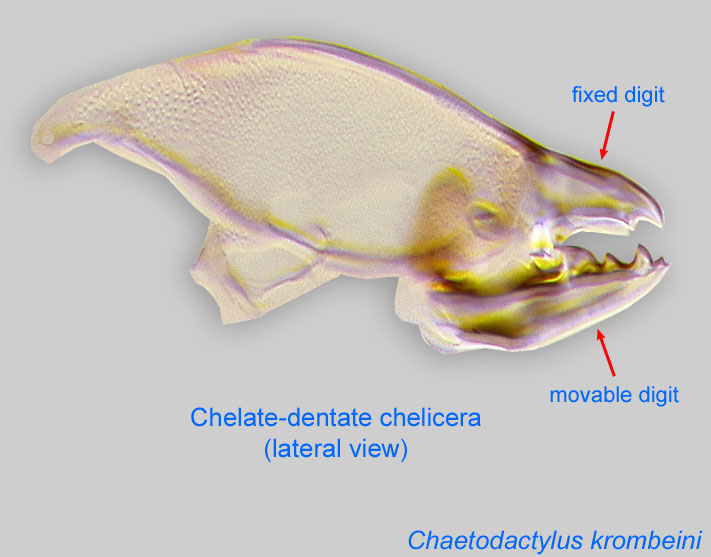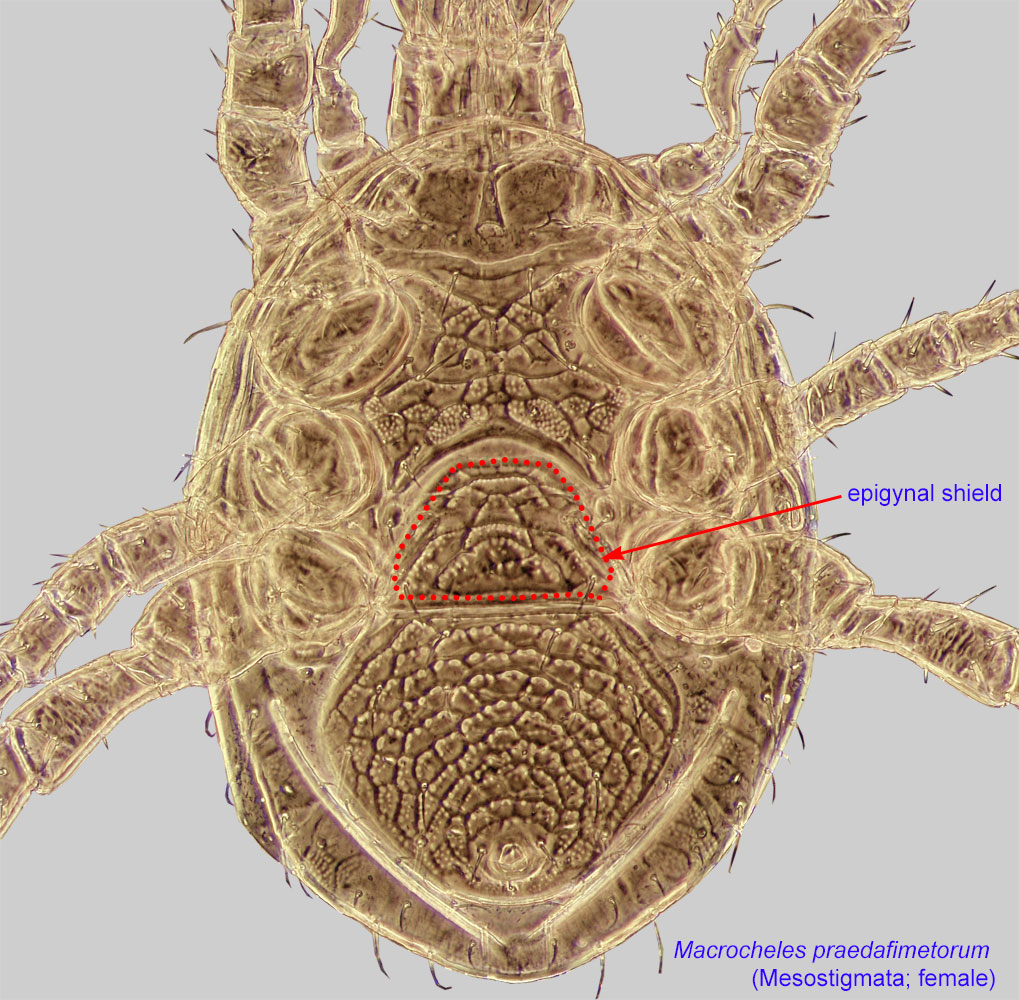unknown; probably feeds on pollen
Raymentia Womersley, 1956
Superorder Parasitiformes » Order Mesostigmata » Suborder Monogynaspida » Hyporder Dermanyssiae » Family Laelapidae » Genus Raymentia
Raymentia anomala Womersley, 1956
Female: Fixed digit of cheliceraechelicera:
Anterior, paired appendage of the body. Primary organ for food acquisition, adapted for chewing, piercing, tearing, sucking, or filtering.
 with large tooth and multidentate crown (Fig. 5). Movable and fixed digit of cheliceraechelicera:
with large tooth and multidentate crown (Fig. 5). Movable and fixed digit of cheliceraechelicera:
Anterior, paired appendage of the body. Primary organ for food acquisition, adapted for chewing, piercing, tearing, sucking, or filtering.
 each with large terminal hook (Fig. 5).
each with large terminal hook (Fig. 5).
Female: Epigynal shieldepigynal shield:
A shield protecting the female genital opening. Well-developed in Mesostigmata. Also known as epigynial shield.
 flanked by auxiliary shields (Fig. 4). Sternal shieldsternal shield:
flanked by auxiliary shields (Fig. 4). Sternal shieldsternal shield:
A shield in the anterior intercoxal region of parasitiform mites that bears one or more pairs of sternal setae.
 with "eroded" posterior margin (Fig. 3). Idiosomal shield narrows posteriorly (Fig. 1).
with "eroded" posterior margin (Fig. 3). Idiosomal shield narrows posteriorly (Fig. 1).
A dichotomous key is available in Walter et al., 2002Walter et al., 2002:
Walter, D. E., J. J. Beard, K. L. Walker amp; K. Sparks. 2002. Of mites and bees: A review of mite-bee associations in Australia and a revision of Raymentia Womersley (Acari : Mesostigmata : Laelapidae), with the description of two new species of mites from Lasioglossum (Parasphecodes) spp. (Hymenoptera : Halictidae). Australian Journal of Entomology. 41:128-148..
Our collection includes an undescribed species from the halictid bee Caenaugochlora costaricensis from Costa Rica. It has large cheliceraechelicera:
Anterior, paired appendage of the body. Primary organ for food acquisition, adapted for chewing, piercing, tearing, sucking, or filtering.
 , with terminal hooks on both digits, and nude epigynal shieldepigynal shield:
, with terminal hooks on both digits, and nude epigynal shieldepigynal shield:
A shield protecting the female genital opening. Well-developed in Mesostigmata. Also known as epigynial shield.
 (as in all species of Raymentia, except for R. anomala). However, there are no auxiliary shields on the sides of the epigynal shieldepigynal shield:
(as in all species of Raymentia, except for R. anomala). However, there are no auxiliary shields on the sides of the epigynal shieldepigynal shield:
A shield protecting the female genital opening. Well-developed in Mesostigmata. Also known as epigynial shield.
 (present in Raymentia); the sternal shieldsternal shield:
(present in Raymentia); the sternal shieldsternal shield:
A shield in the anterior intercoxal region of parasitiform mites that bears one or more pairs of sternal setae.
 does not have "eroded" posterior margin ("eroded" in Raymentia); and the idiosomal shield does not conspicuously narrow posteriorly (conspicuously narrows posteriorly in Raymentia). Thus, the scope of Raymentia should be expanded or a new genus proposed for the species from Caenaugochlora costaricensis.
does not have "eroded" posterior margin ("eroded" in Raymentia); and the idiosomal shield does not conspicuously narrow posteriorly (conspicuously narrows posteriorly in Raymentia). Thus, the scope of Raymentia should be expanded or a new genus proposed for the species from Caenaugochlora costaricensis.
Australia
halictid bees of the genus Lasioglossum, subgenus Parasphecodes
permanentpermanent:
associated exclusively with bees or their close relative, wasps; cannot live without these hosts
The biology of this genus is unknown. All specimens are phoreticphoretic:
Pertaining to phoresy; using another organism (i.e., a host) for dispersal to new habitats. Phoresy can be distinguished from parasitism because feeding typically does not occur during phoresy.
females collected on museum specimens of bees. It has been hypothesized that species of this genus are primarily pollenkitt-feeders (Walter et al., 2002Walter et al., 2002:
Walter, D. E., J. J. Beard, K. L. Walker amp; K. Sparks. 2002. Of mites and bees: A review of mite-bee associations in Australia and a revision of Raymentia Womersley (Acari : Mesostigmata : Laelapidae), with the description of two new species of mites from Lasioglossum (Parasphecodes) spp. (Hymenoptera : Halictidae). Australian Journal of Entomology. 41:128-148.), as the tong-like cheliceraechelicera:
Anterior, paired appendage of the body. Primary organ for food acquisition, adapted for chewing, piercing, tearing, sucking, or filtering.
 would be well suited to collecting nectar-coated pollen grains and holding them during external digestion (Royce and Krantz, 1989Royce and Krantz, 1989:
would be well suited to collecting nectar-coated pollen grains and holding them during external digestion (Royce and Krantz, 1989Royce and Krantz, 1989:
Royce, L. A. amp; G. W. Krantz. 1989. Observations on pollen processing by Pneumolaelaps longanalis (Acari: Laelapidae), a mite associate of bumblebees. Experimental and Applied Acarology.7: 161-165.). This type of interaction is probably best considered kleptoparasitism, and it would seem to be at least weakly detrimental to the developing bee larvae. However, the actual fitness effects of a mite-bee interaction can be difficult to assess. Given the relatively large size of species of Raymentia, the drain on the pollen resources for developing bees could be significant. However, if species of bee host Lasioglossum overstock their nest cells or if the developing larvae produce residues that are the primary food of the mites, then the relationship could be commensal or even mutualistic.